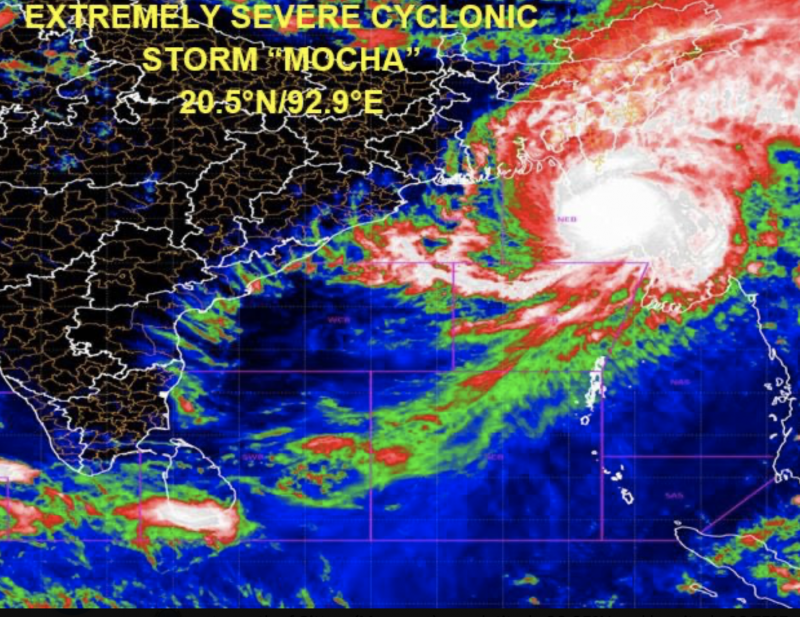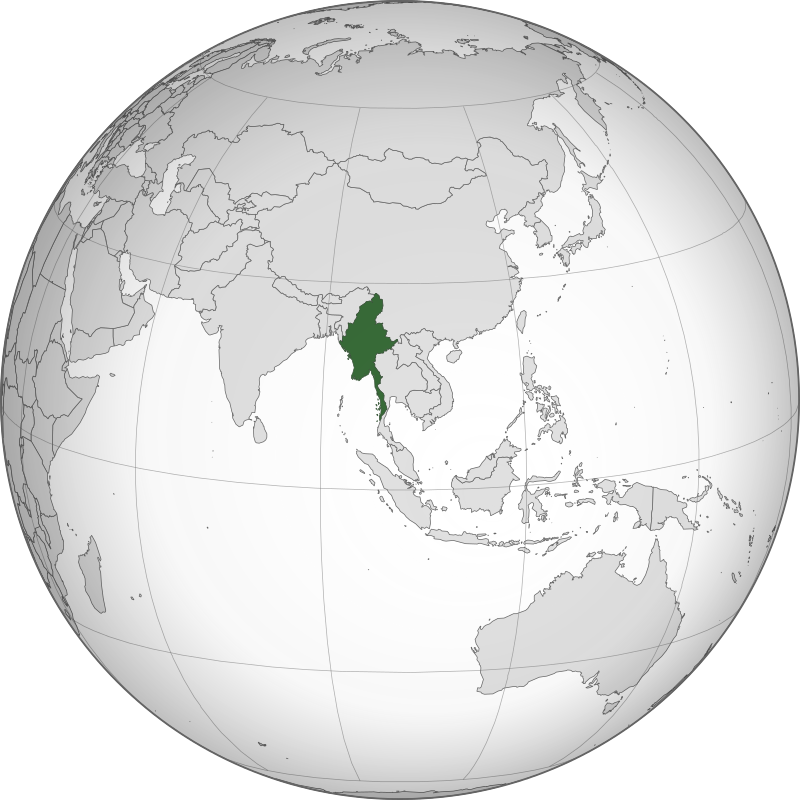Cyclone #Mocha may have set the record for the fastest-weakening tropical cyclone in the North Indian Ocean in recorded history (in terms of 1-min sustained winds), and the fastest-weakening globally since Hurricane Patricia (2015).
It went from 150 kts to 25 kts in only 24 hrs. pic.twitter.com/miGD1EE2jl
— Matthew Cuyugan (@MatthewCuyugan) May 15, 2023
Update: Some good news! After Cyclone Mocha tore into northern Myanmar and Bangladesh, it rapidly weakened once on land. The wind speeds went from around 170 mph (275 kph) to 28 mph (45 kph) in approximately 24 hours.
Mocha has made landfall in Myanmar, near Bangladesh
The India Meteorological Department said on Sunday (May 14, 2023) that Cyclone Mocha has made landfall in western Myanmar, near Bangladesh. It was midafternoon Sunday local time in that region. The storm is bringing winds and heavy rains to this populous, vulnerable and war-torn part of the world, where there are many refugees, and where landslides and floods are now expected. The BBC had reported Saturday that about half a million people were being evacuated to safer areas in southeastern Bangladesh, ahead of the cyclone, which could be the most powerful storm seen in Bangladesh in nearly two decades. The BBC said:
There are concerns the cyclone could hit the world’s largest refugee camp, Cox’s Bazar, where close to a million people live in makeshift homes …
See photos from Aljazeera.com on May 15: Cyclone Mocha batters Myanmar, Bangladesh
From The Guardian weather tracker on May 15: Cyclone Mocha batters Bangladesh and Myanmar
A region of turmoil
According to the BBC, Myanmar has been in turmoil since 2017, when the government began killing and brutalizing the local Rohingya population, forcing them to flee to Bangladesh where many still live in refugee camps.
The tropical cyclone, also called a typhoon, has brought heavy rains to the area. And the low-lying nature of the landscape is expected to exacerbate the flooding issue. The average elevation of Bangladesh is 9 meters (30 feet) above sea level, and the country has a population of about 170 million people. Myanmar’s population is about 54 million. It has mountainous regions, and heavy rainfall could result in landslides.
As the Weather Channel explained:
The Bay of Bengal hosts only 4% of the total tropical cyclones globally, but more than 80% of the fatalities to cyclones are from this region.
The landfall process of Extremely Severe Cyclone Mocha has commenced over north-west Myanmar coast.#CycloneMocha #India #WeatherForecast #IMD @DDNewslive @ndmaindia @airnewsalerts @moesgoi pic.twitter.com/uLvAsRCQwF
— India Meteorological Department (@Indiametdept) May 14, 2023


Videos of Mocha making landfall
Severe weather strikes Camp 26 in Teknaf, one of the southernmost #Rohingya camps, causing significant damage to shelters and displacing many residents. Video by Saiful Arakani.
Cyclone ? Mocha #Bangladesh pic.twitter.com/Q7VRqgDrwi
— Shafiur Rahman (@shafiur) May 14, 2023
More visuals of destruction in #Sittwe as #CycloneMocha landfall process to start soon
Video from Phyo Aung#Myanmar pic.twitter.com/6pHRt7I3Ny
— Weatherman Shubham (@shubhamtorres09) May 14, 2023
Communication tower collapsed at #sittwe #myanmar #Cyclone #Mocha #Mocha_cyclone #CycloneAlert pic.twitter.com/62l8NS7UJM
— Shah (@adnan_shah) May 14, 2023
Big scale devastation in #Sittwe , the capital city of #Rankine state
Video = Kyaw Myo#Myanmar #CycloneMocha pic.twitter.com/MECCgzFn67
— Weatherman Shubham (@shubhamtorres09) May 14, 2023
Cyclone Mocha on Twitter
Observed and forecasted track of presently Extremely Severe cyclonic storm ‘Mocha’#cyclone #cyclonemocha #bayofbengal #IMD #WeatherForecast @DDNewslive @ndmaindia @airnewsalerts @moesgoi pic.twitter.com/yIG5CDkhwx
— India Meteorological Department (@Indiametdept) May 13, 2023
A monster, borderline category 5 equivalent. #Mocha Let’s hope for a miracle. pic.twitter.com/aKxZfPbLTn
— Jeff Berardelli (@WeatherProf) May 13, 2023
The shear that was impacting #Mocha is beginning to subside now as outflow expands to the SE and thunderstorms wrap around the eyewall. With no sign of an EWRC soon on microwave imagery and improving conditions, it stands overshoot intensity forecasts and could reach >130kts. pic.twitter.com/P2p4r7Qo4m
— Deelan Jariwala (@WxTca) May 13, 2023
A monster, borderline category 5 equivalent. #Mocha Let’s hope for a miracle. pic.twitter.com/aKxZfPbLTn
— Jeff Berardelli (@WeatherProf) May 13, 2023
#Bangladeshi ?? fishermen in Teknaf have seen the sea getting angrier.
Two days before #CycloneMocha makes landfall, they have begun portaging their boats to safer ground. We counted over 70 moon-boats this morning.
This is placing an immense strain on their livelihoods. pic.twitter.com/HqwqFBdWni
— ????? (@_arjunjain) May 12, 2023

Bottom line: Powerful cyclone Mocha made landfall on Sunday, May 14, 2023, in Myanmar, near the border of Bangladesh, in a populous, low-lying and war-torn region.
Read more: Tropical Cyclone Freddy sets world record for longevity











